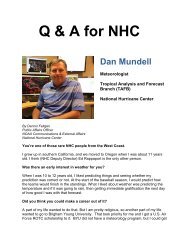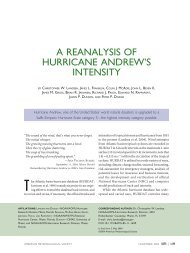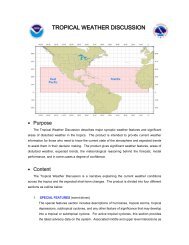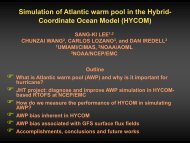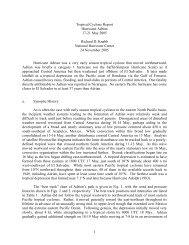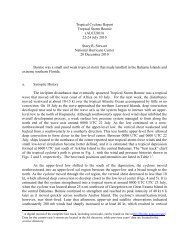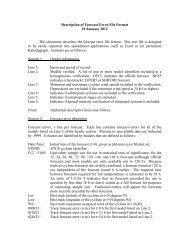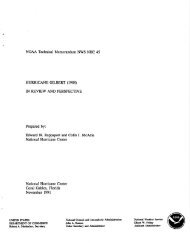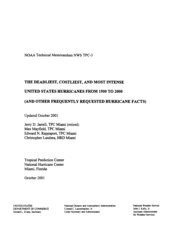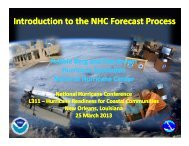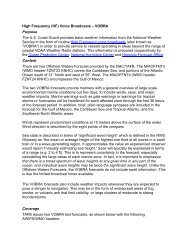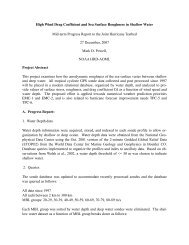Tropical Cyclone Report - National Hurricane Center - NOAA
Tropical Cyclone Report - National Hurricane Center - NOAA
Tropical Cyclone Report - National Hurricane Center - NOAA
Create successful ePaper yourself
Turn your PDF publications into a flip-book with our unique Google optimized e-Paper software.
would typically suggest an intensity of about 77 kt, however SFMR winds did not increase<br />
further, and several surface measurements made around the time of the highest flight-level wind<br />
continued to support an intensity of 60-65 kt. At 2333 UTC, a Texas Tech University <strong>Hurricane</strong><br />
Research Team (TTUHRT) sensor in Buras, Louisiana, measured a peak 1-minute sustained<br />
wind of 65 kt and a gust to 75 kt at an elevation of 2.25 m (7.4 ft). The sensor was located on<br />
top of a levee and was likely affected by wind speed-up effects. Accounting for the possible<br />
speed-up effects and sensor elevation, the TTUHRT estimates that the peak 1-minute sustained<br />
wind at 10 m for that location was 66-67 kt. Isaac’s estimated peak intensity of 70 kt, occurring<br />
between 1800 UTC 28 August and 0600 UTC 29 August, is a blend of the aircraft and surface<br />
data. The highest gust recorded on land was 84 kt by a WeatherBug station in Poydras in St.<br />
Bernard Parish, Louisiana, at 0639 UTC 29 August.<br />
The minimum central pressure of 965 mb around 0300 UTC 29 August is based on a<br />
dropsonde report from the <strong>NOAA</strong> P-3 of a surface pressure of 966 mb with 12 kt of wind at 0238<br />
UTC. Official stations at Pilot’s Station East at Southwest Pass and Grand Isle reported<br />
minimum pressures of 969.8 mb and 970.0 mb, respectively. Minimum pressures of 967.4 mb<br />
and 967.6 mb were reported by unofficial stations at Montegut and Chauvin, Louisiana,<br />
respectively.<br />
Surface observations of sustained tropical-storm-force winds or greater for the Gulf of<br />
Mexico and surrounding coastal areas are shown in Fig. 7a, while surface observations of<br />
tropical-storm-force or greater wind gusts are shown in Fig. 7b.<br />
Storm Surge 3<br />
Isaac’s large wind field led to extensive storm surge flooding along the northern Gulf of<br />
Mexico coastline, especially in southeastern Louisiana, Mississippi, and Alabama. The highest<br />
storm surge measured by a NOS tide gauge was 11.03 ft above normal tide levels at Shell Beach,<br />
Louisiana, on the southern end of Lake Borgne (Fig. 8). A storm surge of 6.69 ft was measured<br />
at Pilottown, Louisiana, near the mouth of the Mississippi River, and a surge of 6.35 ft was<br />
observed in New Orleans at New Canal Station on the southern shore of Lake Pontchartrain. In<br />
Mississippi, a storm surge of 8.00 ft was measured by the NOS gauge at the Bay Waveland<br />
Yacht Club. Farther east, a storm surge of 4.63 ft was measured in Mobile Bay, Alabama, at the<br />
Coast Guard Sector Mobile facility.<br />
In Louisiana, the following inundation levels, expressed above ground level, were<br />
prevalent near the immediate coast, lakeshore, or levee systems due to the storm tide:<br />
3 Several terms are used to describe water levels due to a storm. Storm surge is defined as the abnormal rise of<br />
water generated by a storm, over and above the predicted astronomical tide, and is expressed in terms of height<br />
above normal tide levels. Because storm surge represents the deviation from normal water levels, it is not<br />
referenced to a vertical datum. Storm tide is defined as the water level due to the combination of storm surge and<br />
the astronomical tide, and is expressed in terms of height above a vertical datum, i.e. the North American Vertical<br />
Datum of 1988 (NAVD88) or Mean Lower Low Water (MLLW). Inundation is the total water level that occurs on<br />
normally dry ground as a result of the storm tide, and is expressed in terms of height above ground level. At the<br />
coast, normally dry land is roughly defined as areas higher than the normal high tide line, or Mean Higher High<br />
Water (MHHW).<br />
5




